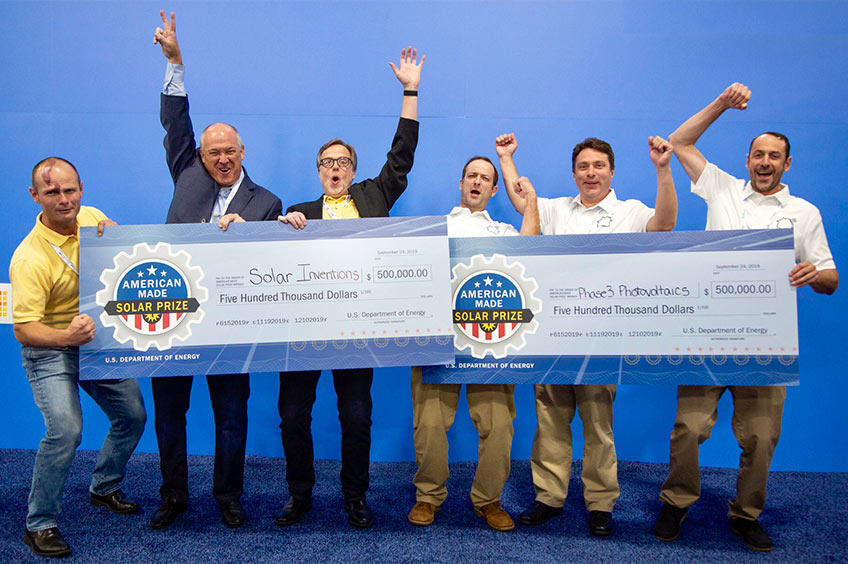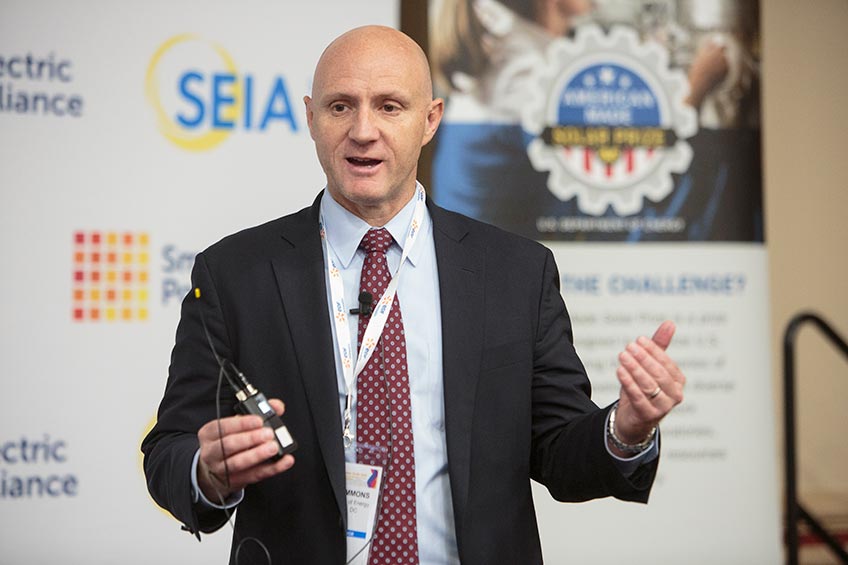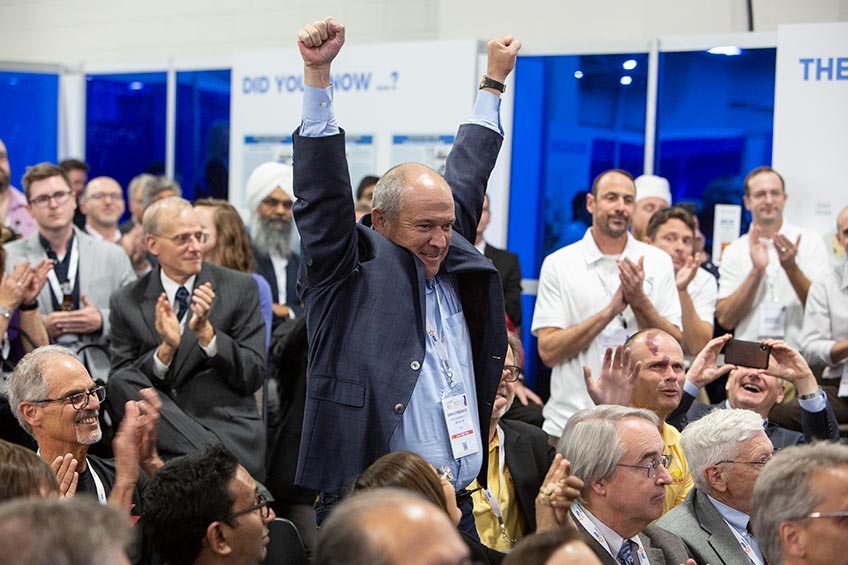First-Ever American-Made Solar Prize Concludes, Awards Round 1 Winners: Phase3 Photovoltaics, Solar Inventions

The two winning teams in Round 1 of the Solar Prize, Phase3 Photovoltaics and Solar Inventions, each took home $500,000 in cash prizes and $150,000 in vouchers.
The sun set on the inaugural round of the American-Made Solar Prize on Sept. 24 in Salt Lake City, where the U.S. Department of Energy (DOE) announced Solar Inventions and Phase3 Photovoltaics as the winners of their own $800,000 prize packages, including $150,000 in technical support vouchers.
Atlanta-based Solar Inventions has developed the configurable-current cell, which effectively divides the cell into multiple sections without physically breaking it, preventing hot spots while improving safety and efficiency. Portland-based Phase3 Photovoltaics is developing solar solutions for the manufactured-home industry. By incorporating solar modules in the manufacturing process, they are able to provide their solar home solution at a substantially lower cost per watt as compared to traditional installation.
The Solar Prize is split into three contests, “Ready,” “Set,” and “Go.” As teams advance through the contests, the field narrows until only two winners remain. After each contest, the advancing teams are awarded a cash prize to further their technology. The timeline between each contest is compressed, with a mere 90 days between the final two contests.
The two winners from Round 1—the first-ever prize in the American-Made Challenges—entered with technologies at different stages. Solar Inventions brought a well-developed product and drew benefit from advancing through each of the contests to accelerate their technology to large-scale distribution.
Bill Nussey from Solar Inventions said his team started trying to innovate at the cell level to increase the safety of the panel and produce more power. With their $50,000 from advancing past the “Ready” contest, Solar Inventions was able to accelerate from science to validation.
“The second (contest) was even more critical,” he said. “We’re going from a science idea that we know works to manufacturing this at volume to be sold at utility and commercial scale across the country next year. We have built, within the scope of four months, a global supply chain. We’re ready to roll this out next year.”
Phase3 Photovoltaics found a gap in the solar market and came up with a low-tech solution—small systems.
“For middle-income people, there’s virtually no solar going on in those homes,” Phase3's Steve Sefchick said. “We found a way to get into the market through manufactured-home facilities. It’s a lot more than standard market pricing. We’re providing a package of materials, design, and training to these manufactured-home facilities.”
After advancing from the “Ready” contest to the “Set” contest, the Phase3 Photovoltaics team used its initial $50,000 to refine its ideas, travel, and reach out to clients to identify their concerns. Sefchick said the clients seemed most concerned about the transportation of the product.
With the final $500,000, Sefchick said his team plans to dive into many more interactions with homebuilders and jump into pilot testing as early as October.

DOE Assistant Secretary for Energy Efficiency and Renewable Energy Daniel Simmons announced Round-1 winners on Sept. 24.
This tandem of teams emerged late from a group of six or eight, according to the National Renewable Energy Laboratory's (NREL's) Debbie Brodt-Giles, program administrator for the American-Made Solar Prize.
“It was a nail-biter,” she said. “I wasn’t sure who was going to win until about half an hour before. Both teams came into the “Go” contest with really strong partnerships, which is one of the things we were looking for at the end of the challenge.”
For both teams, the inaugural round of the American-Made Solar Prize Challenge was a special experience. Nussey's eyes were opened by the passion and drive that DOE and NREL showed toward each competitor.
“The NREL folks and the DOE folks—these are not investors,” he said. “There’s no push and pull like there is with normal investors. They want us—the ones they picked and the ones they couldn’t pick—they want everyone to win. They have such a high motivation. I wish I had reached out earlier.”
Nussey said engaging with NREL and Sandia National Laboratories helped them come up with test plans, as well as validate and clarify their ideas.
“The American-Made Solar Prize really gives you an opportunity to get feedback and input on how your idea will be received and what can be done to help you,” Nussey said.
Both winners made note of the networking and collaboration opportunities among the competitors, not just with the research institutions.
“Believe in yourself and use all the 'Connectors' and 'Power Connectors' to guide you,” Sefchick said. “Not just them, but also your fellow competitors. It was great just meeting and talking with everybody and getting some ideas from what they were doing.”
Eligible competitors are entrepreneurial individuals or teams legally residing or based in the United States. Competitors can be individuals of one or multiple organizations, students, university faculty members, small business owners, researchers, or anyone with the desire and drive to transform an idea into an impactful solution.
“Phase3 Photovoltaics decided to join the challenge to draw attention to an underserved portion of the housing market with respect to solar energy integration,” Phase3 Photovoltaics’ Ethan Good said. “We feel we have been lucky enough to accomplish that aim, but now are tasked with making a meaningful impact through our continued efforts."

The speed of the challenge in comparison to other funding sources helped draw Solar Inventions to the challenge.
“We submitted for three reasons,” Nussey said. “First, the Solar Prize requires a fraction of the time of normal government grants. Second, gaining access to scientists at the national labs helps accelerate our development. Third, as a startup, the flexibility on use of funds was crucial for us to remain nimble and quick. The Solar Prize is all about speed. It seems perfectly matched to the realities of a startup.”
The American-Made Solar Prize is one of several American-Made Challenges designed to accelerate innovation and incentivize the nation’s entrepreneurs to reassert American leadership in the energy marketplace. The Solar Prize is DOE-funded and administered by NREL, one of the national laboratories at which winning teams may redeem their $150,000 in technical assistance vouchers. The Solar Prize was the first of the American-Made Challenges to launch.
The prize itself is broken into rounds, or iterations. These rounds are staggered and begin at different times. Each prize round takes a group of teams through every contest and results in a pair of winning teams. Those winning teams can earn as much as $900,000 by the end, $750,000 in cash. That amounts to a total of $3 million in cash prizes invested in innovation through each round of the prize. This comes in addition to support from the American-Made Network. The network comprises more than 130 universities, national laboratories, startup incubators, accelerators, facilities, investment firms, and other industry partners who support the teams with technical assistance and advice.
With Round 1 now complete, the stage is set for Rounds 2 and 3. DOE has already announced 20 Round-2 semifinalists advancing from the “Ready” to the “Set” contest and opened Round 3 for submissions, due Dec. 10. Learn more on the American-Made Solar Prize website.
Last Updated May 28, 2025
